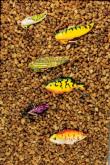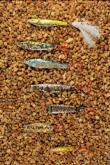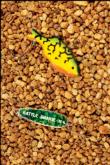Metal picks
Zero in on walleyes with the jigging action of hard metal
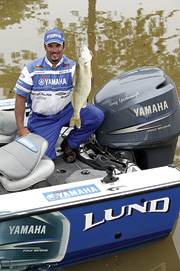
Here is a quiz question: What lures are deadly with walleyes and found in the tackle box of almost every angler, yet rarely given credit as part of a tournament-winning strategy? Answer: hard metal – blade baits and jigging spoons.
“While very popular on certain regional waters, metal baits are underutilized in national competition,” said Wal-Mart RCL Walleye Tour pro Greg Yarbrough of White Lake, Mich. A member of both the Yamaha and Lund angling teams, Yarbrough has included both lures in his walleye-fishing repertoire for years. On more than one occasion, they have helped put him in the money.
Misunderstood metal
While vertical or near-vertical fishing of either a blade or spoon represents a struggling baitfish, each metal lure offers a different perspective to walleyes. Blades attract by vibration in addition to flash. On the other hand, spoons rely almost exclusively on visual flash – although a couple of models include a rattle that may play a role in attracting strikes. While the upstroke sweep of the bait may be an attention-grabber, walleyes always strike these lures during the drop-back, reacting to “injured prey fish” stimuli.
“Why don’t more tournament fishermen use these lures?” Yarbrough said. “There is a combination of factors at work here. First, on the national circuits, anglers who arrive at unfamiliar water must cover a lot of territory quickly during practice to find fish. Trolling is the most popular approach. Jigging a blade or spoon is more of a target approach once fish are found, but anglers tend to overlook it.”
A second reason is sort of a catch-22. There is a learning curve involved in mastering metal. Yarbrough believes many competitive fishermen do not take the time to practice a technique that does not have a track record as a tournament-winning technique, and it is unlikely a blade or spoon will be credited with winning a national tournament until more anglers use them.
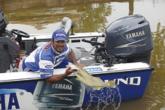 “It’s not about the time of the year that tournaments are held,” he said. “Even though blades and spoons are recognized primarily as a late-fall lure, I find blades equally effective in the spring and spoons effective in the summer.”
“It’s not about the time of the year that tournaments are held,” he said. “Even though blades and spoons are recognized primarily as a late-fall lure, I find blades equally effective in the spring and spoons effective in the summer.”
Nor is it about size of fish. Both blades and spoons will catch a 10-pound walleye as readily as a 3-pound walleye. A properly presented hard metal will draw the strike from whatever size ‘eye is biting.
A third factor may be a simple lack of promotion for the lure. Many tackle manufacturers who include blades and spoons in their line often do not promote them heavily as walleye lures.
For example, the Rattle Snakie Spoon is best known as the lure that caught the 9 1/2-pound Ohio state record smallmouth bass in the mid-1990s. But Ron Perrine, the spoon’s manufacturer and longtime Lake Erie angler, says the Rattle Snakie is also an outstanding walleye spoon.
“I’m a tournament bass angler rather than a tournament walleye angler, so I really haven’t pushed this as a walleye lure,” Perrine said. “But I catch walleyes with my spoon. I’ve been on Erie in the spring when the RCL or other walleye tournaments are in progress. I’ve pinpointed groups of walleyes with my electronics and jigged up a limit of big fish on the spoon within a short time. I’ve always been puzzled why some competitors haven’t done this.”
The Silver Buddy blade bait has a very strong following among smallmouth-bass anglers, but it is also an outstanding walleye lure. Just ask Wal-Mart FLW Tour pro Jack Bell of Kane, Pa. Before becoming hooked on bass competition, Bell’s hometown reputation was that of walleye guru.
“I still fish for walleyes, particularly in the fall on Kinzua Reservoir,” Bell said. “That’s when I break out a Silver Buddy and go to work. If you know where the walleyes hang out, nothing will put a mess of (them) in the boat quicker than a Silver Buddy blade bait. When fish are feeding, a blade is better than live bait.”
On a mission
Yarbrough believes no matter how you look at it, low usage of heavy metal simply comes down to lack of angler education on how, when and where to fish them for walleyes.
The “where” component is fairly simple: Metal jigging lures can be used successfully in almost any water where walleyes are found. Blades and spoons may be jigged vertically from depths of 10 to 40 feet or more. While both work in current situations as well, blades have an edge in angler preference for rivers.
Although he catches walleyes on blades in Lake Erie and Saginaw Bay, Yarbrough really prefers using blades in strong current situations, such as the Detroit River, Saginaw River, Fox River and the Wolf River. In a river system, he considers the blade bait to be an excellent search lure.
On the other hand, he prefers to jig a spoon in lakes on a break, such as a weedline or drop-off – locations he expects walleyes to be positioned.
The “when” component largely comes down to personal choice.
Yarbrough favors the blade bait in the coldwater situations of spring and midfall through early winter. “During the fall, walleyes in rivers are moving and feeding but are somewhat less aggressive,” he said. “I’ll work the blade bait vertically over flat bottoms and through current breaks, trying to place it right in front of their noses. In the cold water of spring when fishing big lakes, I’m more likely to cast a blade bait and work it back.
“As we get into summer, I switch over to a jigging spoon in order to pitch to open pockets in deep cabbage beds as well as work weedlines, drop-offs and midlake rocky reefs.”
Other ‘eye anglers find a spoon to be as effective as a blade in cold water, and few fishermen bring out a blade in the summer for those times when walleyes may be hugging the bottom.
But it is the “how” component that sets expert hard-metal jiggers apart from other ordinary anglers. Becoming a metal-bait master does not require a professional degree. Many of the best blade bait and spoon fishermen are not tournament anglers. Learning to properly present hard metal is critical for everyday walleye anglers and professionals alike.
Yarbrough uses two different types of flat blade baits: a Vib-“E” made in Ohio and a Zip from Wisconsin. Each one has different weight placement and fills a particular niche in his fishing strategy.
“The Vib-`E’ has its weight positioned along the belly, thereby keeping the bait in a more horizontal position,” Yarbrough said. “With a Vib-`E’, I like to drift while vertical jigging with an easy lift/drop routine. I do this in lakes, such as Saginaw Bay and Lake Erie. If I cast and retrieve a blade, the Vib-`E’ is the one I choose.
“On the other hand, the Zip has weight positioned at the head, making it nose-heavy. This gives more tail whip to the lure when you sweep it upward. The Zip is my choice for river fishing, where I slow-troll upstream. I keep the lure on the bottom almost directly under the electric motor. I rip it upward and then sit it back down.”
Yarbrough works a blade with a quick twitch or rip, moving the rod tip from about 5 o’clock to the 4:30 or 3 o’clock position. Some anglers refer to this as “burping a blade” – lifting just high enough to feel it vibrate.
“I’m typically raising the blade 8 to 10 inches,” he said. “When the rod is straight out from your waist, that is about as high as you want to take it. You do not need to rip these blades as hard as many fishermen ripped the original Heddon Sonar blade bait.”
Any time you see anglers imparting a high sweeping motion to their blades, they are most likely overworking the lure. Besides literally wearing themselves out, they run a higher risk of tangling the treble hooks on the line with those high sweeps. And rarely do high rips produce, except at times when walleyes are extremely active. Simply “burping” the blade is all that is needed to trigger a strike from moody ‘eyes.
Another type of blade features a concave body. Represented by the Cicada, curved blades are sometimes regarded as finesse blades because minimal upward movement will make it vibrate. Too forceful a sweep causes a curved blade to roll over.
There are four finishes that Yarbrough considers must-have in blades for walleyes: firetiger, silver with chartreuse back, gold with black back, and chrome with blue back.
“I’ve never encountered a blade-bait bite where at least one of these colors will not produce,” he said.
When summer’s full bloom has arrived on the lake, Yarbrough brings out his jigging spoons. His top picks are the Hopkins and the Northland Buckshot Rattle Spoon. Unlike the more traditional spoon presentation that focuses on deep-water haunts, Yarbrough is more likely to drop his spoons in water less than 20 feet deep.
“With the spoon, most of the time I am pitching to openings in a cabbage bed or a distinct weedline – especially where it meets a drop-off,” he said. “I work the spoon in place by lifting the rod tip from the 9 o’clock position to the 11 o’clock or 11:30 position and letting it back down.”
But instead of a slow flutter back, Yarbrough “slaps” it down from the apex of the upsweep, with the spoon making a sudden dart like a baitfish unexpectedly changing direction.
“When my rod tip reaches the 11 o’clock position, I give the rod a forceful downward sweep to make the spoon behave more erratically,” he said. “I literally slap the rod tip back down to the 9 o’clock position. This triggers more bites for me than the slow flutter.”
On midlake reefs, Yarbrough may jig a spoon anywhere between 20 to 45 feet of water, again applying the slap-down technique, giving the spoon that “escaping prey” appearance.
In water less than 25 feet – whether weedline or drop-off – Yarbrough goes with either a 3/8- or 1/2-ounce spoon. Over deeper structures, he switches to either a 5/8- or 3/4-ounce spoon.
“With regard to spoon finishes, I’m happy with a basic hammered silver or hammered gold,” he said. “Once in a while I paint a chartreuse or orange belly on the side of the spoon.”
Rigged right
Yarbrough employs both spinning and casting outfits for hard-metal jigging, choosing 6 1/2- to 7-foot lengths with medium power and fast tips.
“Unlike some anglers, I don’t put oversize hooks on a blade or spoon, but I will upgrade to Owner hooks of the same size,” he said. Yarbrough notes that Eagle Claw also offers high-quality treble hooks.
“If your hard-metal jigging bait still has standard bronze hooks, it’s time to make a change,” he said. “And yes, I do like red hooks on my hard-metal baits – especially in clear water. I think the red flashes more than bronze or black nickel.”
For spooning, Yarbrough uses 8-pound Berkley IronSilk in hi-vis green. But for blades, he goes to 8-pound FireLine in flame green, tying on an 18- to 24-inch fluorocarbon leader between the braid and the blade. Lures are attached with a Berkley Cross-Lok snap.
“I like visible lines when fishing spoons and blades,” Yarbrough said. “Many times the conditions are windy, which in turn creates a bow in the line between the rod tip and the lure. With a hi-vis line, I can see the line twitch from a strike.”
In an attempt to reduce the line twist that automatically comes with vertical jigging, many anglers use a snap swivel to attach the lure to the line. However, a more effective way to reduce line twist is to tie a high-quality swivel in-line about 18 to 24 inches above the bait. If using a braid, making the leader connection with a swivel works perfectly.
When it comes to hard-metal jigging, there are few absolutes. Although Ron Perrine has never fished a walleye tournament, he certainly spoons up his share on Lake Erie’s Western Basin. His weapon is a 1/2-ounce Rattle Snakie Spoon, and his technique varies based on water temperature.
During the cooler water of early spring and late fall, he drops the spoon to the bottom and winds in slack until his rod tip is positioned about 12 inches above the water. Then he simply lifts the rod tip 6 to 8 inches, pauses briefly, and sits the spoon back down.
With water temperatures above 50 degrees, his presentation changes. Holding the rod at the 8 o’clock position, he sweeps the tip up to about 10 o’clock. This corresponding spoon jump is approximately 28 to 36 inches, but he does not let the spoon free-fall back. Instead, he lowers his rod tip at the same speed as the falling spoon, watching the sink rate of the line while maintaining semitight pressure. This enables the angler to detect a strike immediately and respond with a hookset.
Worden’s new `Showdown’ blade bridges the gap
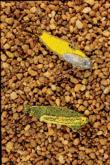 There has been little new in the area of blade baits for some years. Blade design was either the “flat” style of a Heddon Sonar or the “curved” style of the Cicada. Flat blades require a higher and more forceful lift to create vibration. Curved blades feature a concave metal body that is more sensitive to low lift speeds and heights.
There has been little new in the area of blade baits for some years. Blade design was either the “flat” style of a Heddon Sonar or the “curved” style of the Cicada. Flat blades require a higher and more forceful lift to create vibration. Curved blades feature a concave metal body that is more sensitive to low lift speeds and heights.
Worden’s Showdown bridges the gap between flat and curved blades. Designer Tom Seward explains the uniqueness:
“The problem with curved blades is they `blow out’ with fast retrieves and high lift techniques, while flat blades cannot be effective at slow, low lifts,” he said. “The Showdown was designed with a slight curve in the center of the blade, and the rest of the body is flat. This allows for slow, low lifts to activate the blade for sulky walleyes and also allows the faster, higher lift techniques for active fish. All blades and all jigging spoons can catch fish under particular fish moods, but the Showdown allows the widest range of techniques to cover all fish moods.”
